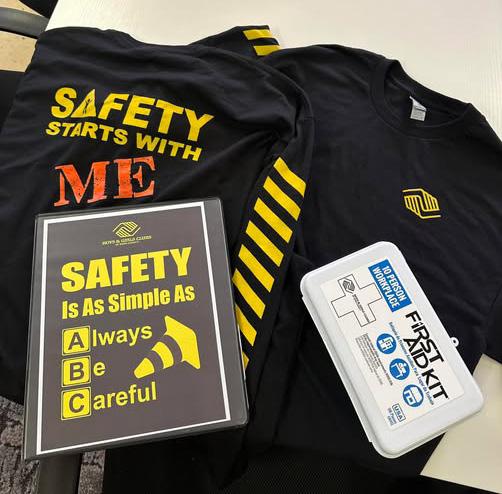
5 minute read
Fostering a Culture of Safety at the Boys & Girls Clubs of Kern County
Several years ago, the Boys & Girls Clubs of Kern County made a strategic commitment—to create and sustain a culture of safety encompassing youth, team members, and community stakeholders. This initiative was designed not only to reinforce compliance but to embed safety into the very fabric of the organization’s daily operations and long-term planning.
In typical nonprofit fashion, this endeavor began with the formation of a Board-led Safety Committee. Spearheaded by a board member with professional expertise in corporate safety, the committee included additional board members, staff, volunteers, and external safety experts. Their mission was to integrate comprehensive safety practices into every level of the Club’s work.
The committee identified three core areas of focus:
Youth & Staff Safety – Ensuring all children and employees are protected while participating in programs, accessing facilities, and interacting with Clubmates, Staff or visitors.
Facility Safety – Maintaining safe environments at Clubhouses, partner locations, off-site events and during public outings.
Community Safety – Providing secure experiences for all guests, parents, and partners during visits or events.
Achieving these goals required an organization wide effort, including securing professional training, engaging team members, and involving youth in safety planning and implementation. The ultimate objective was for safety to become second nature—while remaining adaptable to emerging risks, technological change, and evolving leadership.

As part of the process, the organization conducted an internal review to identify any gaps. This honest appraisal
revealed instances of outdated practices and lapses in policy adherence, often due to staff turnover and loss of institutional knowledge. Additionally, there were areas where existing strategies had not kept pace with the rapid evolution of technology and youth access to digital platforms.
This introspective period proved crucial. It unearthed inefficiencies but also highlighted that many improvements required only modest changes to achieve higher standards of excellence. The leadership team embraced the challenge, adopting a forward-thinking mindset and committing to continuous improvement.
A pivotal development in this safety transformation was the introduction of a third-party safety assessment, conducted across all 71 Club locations. The assessment, which now occurs annually, validated the organization’s progress and helped further standardize safety procedures. The findings revealed a stronger organizational alignment around safety protocols, with staff better equipped to recognize, activate, and refine safety strategies.
Organizational structure also evolved to support this cultural shift. A Safety Compliance Officer role was added to the management team, filled by a Club alumnus with both program development experience and a deep passion for youth protection. This role has since expanded to a team of three trained professionals, reflecting the Club’s scale and the critical importance of sustained safety leadership.

revealed instances of outdated practices and lapses in policy adherence, often due to staff turnover and loss of institutional knowledge. Additionally, there were areas where existing strategies had not kept pace with the rapid evolution of technology and youth access to digital platforms.
This introspective period proved crucial. It unearthed inefficiencies but also highlighted that many improvements required only modest changes to achieve higher standards of excellence. The leadership team embraced the challenge, adopting a forward-thinking mindset and committing to continuous improvement.
A pivotal development in this safety transformation was the introduction of a third-party safety assessment, conducted across all 71 Club locations. The assessment, which now occurs annually, validated the organization’s progress and helped further standardize safety procedures. The findings revealed a stronger organizational alignment around safety protocols, with staff better equipped to recognize, activate, and refine safety strategies.
Organizational structure also evolved to support this cultural shift. A Safety Compliance Officer role was added to the management team, filled by a Club alumnus with both program development experience and a deep passion for youth protection. This role has since expanded to a team of three trained professionals, reflecting the Club’s scale and the critical importance of sustained safety leadership.
Another pioneering step was the formation of Youth Safety Leadership Teams at each of the 71 sites. These teams, composed of Club members, are trained to lead peer-driven safety initiatives, conduct assessments, report concerns, and engage with safety professionals. This model of youth-led safety is believed to be the first of its kind nationally and exemplifies the Club’s commitment to youth empowerment and innovation.
Data analysis now plays a central role in shaping safety strategies. For instance, a pattern was identified where injuries among eightyear-old boys spiked around 3:30 PM—often coinciding with active play sessions. This insight led to new approaches in supervision, risk evaluation, and activity planning. Understanding behavioral trends and common injury points has enabled the Club to proactively tailor its programming for improved outcomes.
While certain behaviors—like the boundless energy and daring nature of eight-year-old boys—can never be completely eliminated, the Club has implemented coaching and guidance strategies to reduce unnecessary risks. Safety is no longer seen as a static checklist but as a dynamic, evolving priority that requires constant vigilance, reflection, and innovation.
Today, the Boys & Girls Clubs of Kern County serve over 8,000 children county-wide, supported by dedicated youth development professionals. The organization’s culture of safety is deeply embedded—not just in its policies and procedures, but in the attitudes and actions of its entire community.
The journey is ongoing, but the foundation is strong. The Boys & Girls Club continues to model what it means to put safety first—because every child deserves a secure space to grow, learn, and thrive.
Be safe out there…the Club definitely is!


